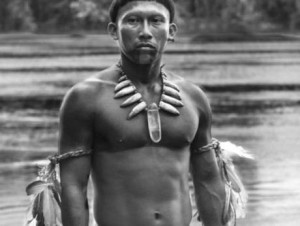 Embrace of the Serpent, a film by Colombian director Ciro Guerra, begins enigmatically. Standing on the banks of an inlet to the Amazon River, a fierce young shaman sees a small boat approaching, rowed by another native wearing western clothing, and in the boat, a haggard, exhausted looking white man. The shaman prepares to attack the strangers, but the native pleads with him to help cure the sickness of his friend, a German ethnologist named Theodor Koch-Grunberg. But the shaman, who believes his entire tribe was killed by white men, refuses, only to change his mind when Theo claims to have seen survivors of his people and offers to take him to where they are. The shaman, whose name is Karamakate, revives the explorer’s energies by blowing a certain powder into his nose. This is only a temporary solution. They must seek the rare Yakura plant, which will cure his malady completely, but he, the white ethnologist, must agree to obey sacred prohibitions during the journey—including abstention from meat and fish. And thus begins an arduous voyage, beautiful but also terrifying, down the great Amazon. It is 1909, and the lives of the indigenous people of Colombia have been decimated by the whites who have come to create rubber plantations, enslaving and killing as they go.
Embrace of the Serpent, a film by Colombian director Ciro Guerra, begins enigmatically. Standing on the banks of an inlet to the Amazon River, a fierce young shaman sees a small boat approaching, rowed by another native wearing western clothing, and in the boat, a haggard, exhausted looking white man. The shaman prepares to attack the strangers, but the native pleads with him to help cure the sickness of his friend, a German ethnologist named Theodor Koch-Grunberg. But the shaman, who believes his entire tribe was killed by white men, refuses, only to change his mind when Theo claims to have seen survivors of his people and offers to take him to where they are. The shaman, whose name is Karamakate, revives the explorer’s energies by blowing a certain powder into his nose. This is only a temporary solution. They must seek the rare Yakura plant, which will cure his malady completely, but he, the white ethnologist, must agree to obey sacred prohibitions during the journey—including abstention from meat and fish. And thus begins an arduous voyage, beautiful but also terrifying, down the great Amazon. It is 1909, and the lives of the indigenous people of Colombia have been decimated by the whites who have come to create rubber plantations, enslaving and killing as they go.
Shot in a beautifully crisp black and white that evokes a sense of awe and mystery before the vast rain forest, the film follows the travelers as they skim along the river, encountering scenes of pain and corruption whenever they stop for supplies. But Guerra has also devised an ingenious double narrative that focuses our attention on the lonely figure of Karamakate. In 1940, another white man encounters the now older and wiser shaman. He is an American ethnobotanist named Richard Evans Schultes, in search of the very same Yakura plant that he read about in the published diaries of the earlier explorer. In a timeline that interweaves with the earlier story, these two men follow the same path down the river, taking a journey in which greater truths emerge about the human heart, and the good and evil it contains.
The film is based on the actual diaries of the two scientists, Koch-Grunberg and Schultes. But in an interesting counterpart to The Revenant, which I reviewed last week, the stories of Embrace of the Serpent put the Indians, the original people of the land, in the center of the film, prompting us to see the history of colonialism through their eyes. Non-professional actors Nilbio Torres and Antonio Bolivar play the young and old Karmakate respectively, and they are both excellent, tremendously moving in their sense of strength, emotional response, and ultimately, wisdom. The shaman must endure his own crisis of faith, and come to the realization of what he has to give, and to whom. In a film of such overwhelming historical and political resonance, it is remarkable that the meaning sought and achieved is one of dream and vision. Embrace of the Serpent demands our rapt attention, and rewards it.

